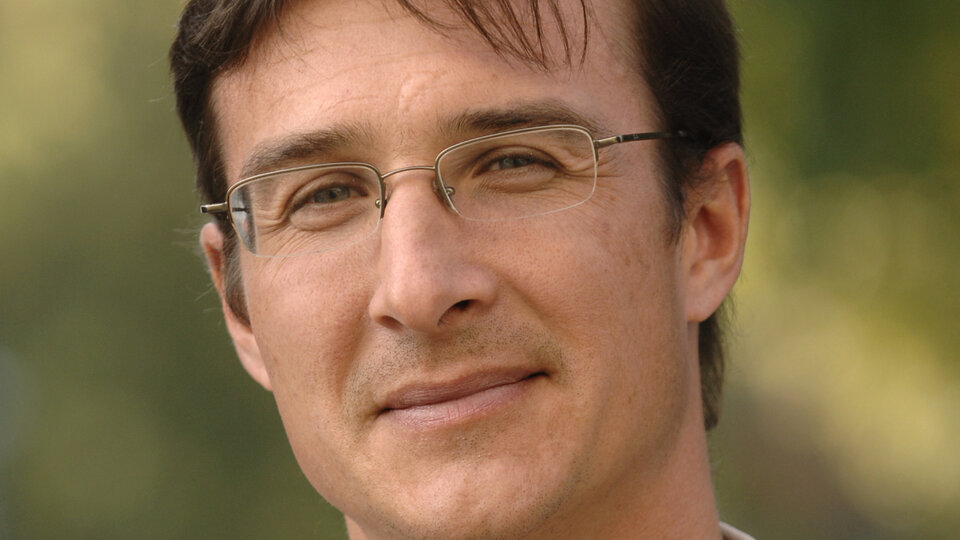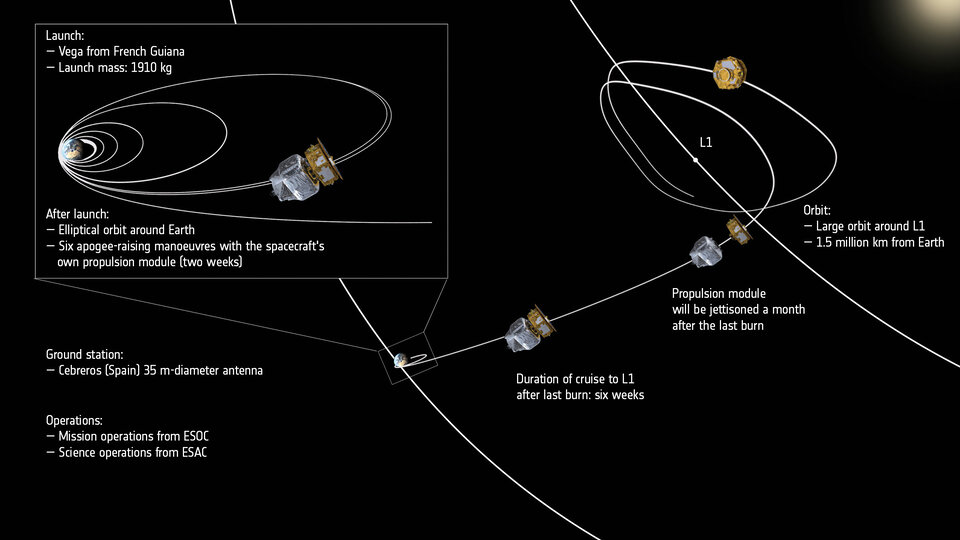LISA Pathfinder operations
Editor's note: This page is no longer being updated, but will be preserved as a record. Click here for the latest information on LISA Pathfinder.
LISA Pathfinder is conducting in-flight testing of the concept of low-frequency gravitational wave detection: it will put two test masses in a near-perfect gravitational free-fall, and control and measure their motion with unprecedented accuracy. To do this it is using inertial sensors, a laser metrology system, a drag-free control system and an ultra-precise micro-propulsion system.
The mission aims to demonstrate, in a space environment, that free-falling bodies follow geodesics in space-time, by more than two orders of magnitude better than any past, present, or planned mission. Specifically, it must:
• Demonstrate drag-free flight and attitude control in a spacecraft containing two free proof masses
• Test feasibility of laser interferometry with low frequency picometre resolution
• Test the endurance of the instruments and hardware in the harsh space environment
In other words, LISA Pathfinder is testing – in spaceflight – the technology needed to detect gravitational waves in space for the very first time.
Gravitational waves are ripples in space-time predicted by Albert Einstein’s Theory of General Relativity. Detecting gravitational waves would greatly enhance our knowledge of General Relativity and allow scientists to detect the impact of astronomical events which are thought to cause a miniscule distortion in the fabric of space itself.
Mission operations at ESOC
For the flight control team, operating LISA Pathfinder presents demanding and unique challenges, including:
- A complex orbit-raising strategy to transfer LISA Pathfinder from a Low Earth Orbit to an L1 orbit
- Maintaining the inherently unstable orbit about L1
- Safely maintaining the science module while commissioning a highly complex technology demonstration payload with a limited mission duration
LISA Pathfinder was launched on 3 December 2015 at 04:04 GMT (05:04 CET) onboard a Vega rocket from Kourou, French Guiana. It was initially placed into a slightly elliptical parking orbit. From there, it is using its own propulsion module to reach its final operational orbit, a 500 000 by 800 000-km halo orbit around the first Sun-Earth Lagrange point, at 1.5 million km from Earth. LISA Pathfinder’s initial operational phase will last 11 months and the mission could be extended by an additional 6 months.
LISA Pathfinder is testing certain technologies required for future LISA-like space missions that cannot be proven on Earth due to our planet's gravity, including:
- Demonstrating that a test mass can be put in pure gravitational free-fall
- Demonstrating laser interferometry with a free-falling mirror
- Assessing the reliability of micro-Newton thrusters, lasers and optics in a space environment
| ROLE | Space observatory (technology proof) |
| LAUNCH DATE | 3 December 2015 |
| LAUNCHER/LOCATION | Vega/Kourou |
| LAUNCH MASS | ~1910 kg |
| ORBIT | Halo orbit about the Lagrangian point L1 (1.5 million km from Earth) |
| NOMINAL MISSION | 11 months; may be extended up to 17 months |
| + Preparing the technology to test gravitational-wave detection in space + | |
The LISA Pathfinder Mission Operations Centre (MOC) is located at ESOC, Darmstadt, Germany.
The MOC is responsible for the critical launch and early orbit phase (LEOP), the transfer phase and all operations during the routine phase; the Flight Control Team will maintain contact with the spacecraft for eight hours per day via ESA’s Estrack ground station network.
The Science and Technology Operations Centre (STOC) is the point of interface to the scientific community, and is responsible for the payload scheduling (both long and short-term), quick-look data analysis, data processing and archiving.
Development of the STOC is managed from ESA’s European Space Astronomy Centre (ESAC), Spain. However, during science operations of the LISA Technology Package (LTP), the STOC will be re-located to ESOC. This is to enable the required close contact between science operations planning and mission operations.
The Flight Control Team

Ian Harrison joined LISA Pathfinder as Spacecraft Operations Manager (SOM) in 2006 and since then he has been working to assemble a team of engineers to operate the mission and to develop the overall architecture for the mission operations system and ground segment.
The Flight Control Team (FCT) began training intensively for the LEOP, commissioning and routine mission phases in June 2015 after many years of mission preparation. In total, 33 simulation training sessions were conducted prior to liftoff.
One notable challenge for the FCT has been the development of drag-free flight-control techniques. This means working closely with the scientific operations team, project teams, industrial teams and hardware provider teams to match the scientific needs to the space and ground segment capabilities, and to correctly and safely develop procedures for drag-free operations.
In addition to the mission-dedicated FCT, other experts from ESOC are playing a daily role in managing and controlling flight operations, including engineers from flight dynamics, ground stations, computers and communications and mission data systems.
Mission operations overview
LISA Pathfinder was lofted into orbit on 3 December 2015 on board a Vega rocket from the European Spaceport in Kourou, French Guiana. The critical Launch and Early Orbit Phase is being controlled from ESOC.
The Vega upper stage injected LISA Pathfinder into an elliptical orbit inclined at 6° to the equator, with apogee near 1540 km and a perigee at 200 km.

From there, it will use its propulsion module (with a series of six apogee burns) to enter into a transfer orbit and eventually reach its operational orbit around L1, the first Lagrange point of the Sun-Earth system, around the end of January 2016.
After the transfer orbit, the propulsion module will separate from the spacecraft and LISA Pathfinder will continue to its science mission, stabilized by a set of micro-Newton thrusters, entering a Lissajous orbit around L1 at 500 000 km x 800 000 km.
Very accurate navigation and very careful timing of the propulsion module separation is necessary to enable a successful transfer into the operational orbit.
The L1 orbit has been chosen because it is an intrinsically 'quiet' place in space. It is far away from massive bodies, which induce tidal forces on the spacecraft, has constant illumination from the Sun, and has a quasi-constant Earth distance for communication. This orbit fulfils LISA Pathfinder's stringent requirements concerning thermal and gravitational stability.

Nominal 180-day mission
Following the initial on-orbit check-out and instrument calibration, the in-flight demonstration of the LISA technology will take place in the first half of 2016. The nominal lifetime of the mission is 180 days; this includes the LISA Technology Package (LTP) instrument operations (90 days), Disturbance Reduction System (DRS − supplied by NASA) instrument operations (90 days) and a period of joint operations (30 days).
These instruments are being flown because their technology cannot be demonstrated on Earth. As such they will be in a constant ‘state of commissioning’ during the entire mission period, with the very large learning curve this entails.
Ground segment

In routine operations, communications will be maintained via ESA’s Estrack ground station network using the 35-m diameter deep-space antennas; the communications link will be established for six to eight hours per day.
During each pass, the data stored on board will be retrieved, spacecraft tracking will be performed and the command timeline will be uplinked.
The LISA Pathfinder ground segment comprises two operational centres, both provided by ESA:
- The MOC is responsible for LEOP, the transfer phase, and all operations during the routine phase and maintaining contact via Estrack
- STOC is the point of interface to the scientific community, and is responsible for the payload scheduling (both long and short-term), quick-look data analysis, data processing and archiving
The design of the mission provides a high level of autonomy. This minimises real-time intervention to mission operation commands sent from ground during LEOP, the transfer and in-orbit operation phases.
A command schedule covering three days of operation will be periodically uploaded from ground and executed autonomously on board. The data generated on board (satellite housekeeping and technology data) will be stored in a mass memory that will be downloaded to ground daily. Such autonomy allows ground operations to be limited to eight hours a day.
The major task of the STOC is to plan and validate the utilisation and related configuration of the scientific instruments on board the spacecraft, derive from the mission products the science and technology results, and feed these results into later planned instrument activities.
The platform

The spacecraft has an octagonal shape and is 2.9 m high with propulsion module attached and 2.1 m in diameter; the science module once separated is 0.85 m high with a 2.1 m diameter.
The platform comprises all the necessary systems for communications, on-board computing and data management, propulsion, attitude and orbit control, thermal control and power generation necessary to support the instrument.
In order to attain its scientific objectives, the spacecraft is equipped with two innovative flight control systems: the Drag-Free and Attitude Control System, and the Drag-Free Propulsion System.
The Payload
LISA Pathfinder will carry two test packages: the LISA Technology Package (LTP), provided by European institutes and industry, and the Disturbance Reduction System (DRS), provided by NASA.

LISA Technology Package
The LTP represents one arm of the (future) LISA interferometer, in which the distance between the two proof masses is reduced from 5 million kilometres to 35 centimetres. As in LISA, the proof masses fulfil a double role: they serve as mirrors for the interferometer and as inertial references for the drag-free control system. The LTP also contains the mechanisms to hold and release the test masses, to discharge any charge build up on the test masses or electrode housing and to inject and measure the effects of thermal and magnetic disturbances on the system.
Disturbance Reduction System
The Disturbance Reduction System (DRS) is a NASA-supplied system, which contributes to the LISA Pathfinder mission goals and uses the European LTP. The DRS consists of two clusters of colloidal thrusters that use ionised droplets of a colloidal solution accelerated in an electric field to provide micro-propulsion, and drag-free control software residing on a dedicated computer. The DRS will use the sensor information of the LTP (test masses position and attitude) to control the spacecraft attitude with independent drag-free software and will use the colloidal thrusters as actuators.




